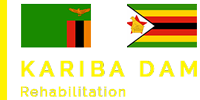The rehabilitation of the Kariba Dam was the subject of interesting discussions at the Africa 2019 Water Storage and Hydropower Development for Africa International Conference in early April when the Zambezi River Authority presented its experiences on the Kariba Dam Rehabilitation Project to international dam engineering and hydropower development experts attending the conference. The conference was the third international conference focusing on water storage and renewable energy development in Africa jointly hosted by the International Commission on Large Dams (ICOLD) and the International Journal on Hydropower & Dams.
The conference which was held in Windhoek, Namibia, from 02 to 04 April also attracted major hydro development programmes from Angola, Mozambique, Lesotho, Ethiopia, Uganda, Guinea, Kenya, Cameroon, Malawi, South Africa, the Democratic Republic of Congo and host country, Namibia. Delegates included representatives of government, project implementers and water and power utilities, and officers from the African Union, the African Development Bank, World Bank, NEPAD, the United Nations Economic Commission for Africa (UNECA), the International Commission on Irrigation and Drainage (ICID) and engineering experts from across the globe.
Prior to the conference, Engineer Munyaradzi Munodawafa, Chief Executive of the Zambezi River Authority, emphasized the importance of the Kariba Dam to energy security and economic development in the region and confirmed that the Kariba Dam Rehabilitation Project is of significant interest to stakeholders in the hydropower and water infrastructure sector and also the industrial, mining, agricultural, tourism and water management sectors in Zambia and Zimbabwe.
“To the engineering fraternity, the two components of the KDRP – the plunge pool reshaping and spillway refurbishment – are bold and interesting. For example, reshaping the plunge pool of an existing, operational dam of the scale of Kariba has never been done before. As a result of this pioneering endeavour, the engineering fraternity is interested in the intense research and hydraulic modelling that went into the development of the solution to stabilize the plunge pool, and also in the possible effect of the excavations on the dam wall.”
“At Africa 2019, ZRA presented a paper on the rehabilitation of the Kariba spillway with Stucky Limited, the consulting engineers on the KDRP project. The rehabilitation of the upstream control section of the spillway to address the natural wear and tear on operating parts, and replacing the existing motorized gantry with a higher capacity gantry capable of operating an emergency gate, will mitigate potential risk of failure of the operation of the spillway. Some of the work will be done underwater by specialist divers, and although underwater work is not unique, it remains risky only to be undertaken by experienced, highly skilled engineers,” continued Engineer Munodawafa. “The international engineering fraternity is observing the progress on the KDRP and is keenly awaiting its successful outcome.”
Africa 2019 followed the 8th technical Joint Mission of multiple stakeholders directly involved in the implementation of the KDRP held in Siavonga from 25 to 29 March. The Joint Mission was attended by members of the panel of experts which provides technical guidance and advice in the areas of engineering, concrete technology, hydrology and the social and environmental aspects of infrastructure projects, amongst others; the project financiers; the National Authorising Office of the European Development Fund, the contracting party for the plunge pool works; Stucky Limited, the consulting engineers providing technical services and supervising the KDRP works; Tractebel, consulting engineers and long-term advisors to the ZRA; Razel-BEC, the contractors carrying out the plunge pool works, and the Zambian and Zimbabwean power utilities.
The KDRP is funded jointly by the European Union, World Bank, African Development Bank, the Swedish government and the Zambezi River Authority on behalf of the governments of Zambia and Zimbabwe.






